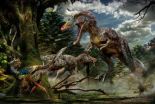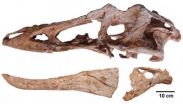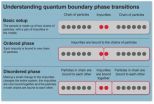(Press-News.org) Scientists have discovered a new species of long-snouted tyrannosaur, nicknamed Pinocchio rex, which stalked the Earth more than 66 million years ago.
Researchers say the animal, which belonged to the same dinosaur family as Tyrannosaurus rex, was a fearsome carnivore that lived in Asia during the late Cretaceous period.
The newly found ancient predator looked very different from most other tyrannosaurs. It had an elongated skull and long, narrow teeth compared with the deeper, more powerful jaws and thick teeth of a conventional T. rex.
Palaeontologists were uncertain of the existence of long-snouted tyrannosaurs until the remains of the dinosaur – named Qianzhousaurus sinensis – were unearthed in southern China.
Until now, only two fossilised tyrannosaurs with elongated heads had been found, both of which were juveniles. It was unclear whether these were a new class of dinosaur or if they were at an early growth stage, and might have gone on to develop deeper, more robust skulls.
The new specimen, described by scientists from the Chinese Academy of Geological Sciences and the University of Edinburgh, is of an animal nearing adulthood. It was found largely intact and remarkably well preserved, thereby confirming the existence of tyrannosaur species with long snouts.
Experts say Qianzhousaurus sinensis lived alongside deep-snouted tyrannosaurs but would not have been in direct competition with them, as they were larger and probably hunted different prey.
Following the find, researchers have created a new branch of the tyrannosaur family for specimens with very long snouts, and they expect more dinosaurs to be added to the group as excavations in Asia continue to identify new species.
Qianzhousaurus sinensis lived until around 66 million years ago when all of the dinosaurs became extinct, likely as the result of a deadly asteroid impact.
Findings from the study, funded by the Natural Science Foundation of China and the National Science Foundation, are published in the journal Nature Communications.
Dr Steve Brusatte, of the University of Edinburgh's School of GeoSciences, and one of the authors of the study, said: "This is a different breed of tyrannosaur. It has the familiar toothy grin of T. rex, but its snout was much longer and it had a row of horns on its nose. It might have looked a little comical, but it would have been as deadly as any other tyrannosaur, and maybe even a little faster and stealthier."
Professor Junchang Lü, of the Institute of Geology, Chinese Academy of Geological Sciences, said: "The new discovery is very important. Along with Alioramus from Mongolia, it shows that the long-snouted tyrannosaurids were widely distributed in Asia. Although we are only starting to learn about them, the long-snouted tyrannosaurs were apparently one of the main groups of predatory dinosaurs in Asia."
INFORMATION: END
Newly found dinosaur is long-nosed cousin of Tyrannosaurus rex
University of Edinburgh
2014-05-07
ELSE PRESS RELEASES FROM THIS DATE:
Melting an entire iceberg with a hot poker: Spotting phase changes triggered by impurities
2014-05-07
"What a curious feeling," says Alice in Lewis Carroll's tale, as she shrinks to a fraction of her size, and everything around her suddenly looks totally unfamiliar. Scientists too have to get used to these curious feelings when they examine matter on tiny scales and at low temperatures: all the behaviour we are used to seeing around us is turned on its head.
In research published today in the journal Nature Communications, UCL scientists have made a startling discovery about a familiar physical effect in this unfamiliar setting.
Phase transitions are a category of ...
Sprites form at plasma irregularities in the lower ionosphere
2014-05-07
Atmospheric sprites have been known for nearly a century, but their origins were a mystery. Now, a team of researchers has evidence that sprites form at plasma irregularities and may be useful in remote sensing of the lower ionosphere.
"We are trying to understand the origins of this phenomenon," said Victor Pasko, professor of electrical engineering, Penn State. "We would like to know how sprites are initiated and how they develop."
Sprites are an optical phenomenon that occur above thunderstorms in the D region of the ionosphere, the area of the atmosphere just above ...
International molecular screening program for metastatic breast cancer AURORA at IMPAKT
2014-05-07
While research has made great strides in recent decades to improve and significantly extend the lives of patients with early breast cancer, the needs of patients with advanced or metastatic disease have largely been ignored. Moreover, despite the fact that the overall breast cancer death rate has dropped steadily over the last decade and significant improvements in survival have been made, metastatic breast cancer represents the leading cause of death among patients with the disease.
In this context the Breast International Group (BIG) recently launched AURORA, which ...
Nearest bright 'hypervelocity star' found
2014-05-07
SALT LAKE CITY, May 7, 2014 – A University of Utah-led team discovered a "hypervelocity star" that is the closest, second-brightest and among the largest of 20 found so far. Speeding at more than 1 million mph, the star may provide clues about the supermassive black hole at the center of our Milky Way and the halo of mysterious "dark matter" surrounding the galaxy, astronomers say.
"The hypervelocity star tells us a lot about our galaxy – especially its center and the dark matter halo," says Zheng Zheng, an assistant professor of physics and astronomy and lead author ...
All teeth and claws? New study sheds light on dinosaur claw function
2014-05-07
Theropod dinosaurs, a group which includes such famous species as Tyrannosaurus rex and Velociraptor, are often regarded as carnivorous and predatory animals, using their sharp teeth and claws to capture and dispatch prey. However, a detailed look at the claws on their forelimbs revealed that the form and shape of theropod claws are highly variable and might also have been used for other tasks.
Inspired by this broad spectrum of claw morphologies, Dr Stephan Lautenschlager from Bristol's School of Earth Sciences studied the differences in claw shape and how these are ...
Revealing the healing of Dino-sores
2014-05-07
Scientists have used state-of-the-art imaging techniques to examine the cracks, fractures and breaks in the bones of a 150 million-year-old predatory dinosaur.
The University of Manchester researchers say their groundbreaking work – using synchrotron-imaging techniques – sheds new light, literally, on the healing process that took place when these magnificent animals were still alive.
The research, published in the Royal Society journal Interface, took advantage of the fact that dinosaur bones occasionally preserve evidence of trauma, sickness and the subsequent signs ...
Study finds pregnant women show increased activity in right side of brain
2014-05-07
Pregnant women show increased activity in the area of the brain related to emotional skills as they prepare to bond with their babies, according to a new study by scientists at Royal Holloway, University of London.
The research, which will be presented at the British Psychological Society's annual conference on Wednesday 7 May, found that pregnant women use the right side of their brain more than new mothers do when they look at faces with emotive expressions.
"Our findings give us a significant insight into the 'baby brain' phenomenon that makes a woman more sensitive ...
Mass vaccination campaigns reduce the substantial burden of yellow fever in Africa
2014-05-07
Yellow fever, an acute viral disease, is estimated to have been responsible for 78,000 deaths in Africa in 2013 according to new research published in PLOS Medicine this week. The research by Neil Ferguson from Imperial College London, UK and colleagues from Imperial College, WHO and other institutions also estimates that recent mass vaccination campaigns against yellow fever have led to a 27% decrease in the burden of yellow fever across Africa in 2013.
Yellow fever is a serious viral disease that affects people living in and visiting tropical regions of Africa and ...
Water from improved sources is not consistently safe
2014-05-07
Although water from improved sources (such as piped water and bore holes) is less likely to contain fecal contamination than water from unimproved sources, improved sources in low- and middle-income countries are not consistently safe, according to a study by US and UK researchers, published in this week's PLOS Medicine.
These findings are important as WHO and UNICEF track progress towards the Millennium Development Goals water target using the indicator "use of an improved source": this study shows that assuming that "improved" water sources are safe greatly overestimates ...
Dinosaurs and birds kept evolving by shrinking
2014-05-07
Although most dinosaurs went extinct 65 million years ago, one dinosaur lineage survived and lives on today as a major evolutionary success story – the birds. But to what does this lineage owe its success? A study that has 'weighed' hundreds of dinosaurs now suggests that shrinking their bodies may have helped this group to continue exploiting new ecological niches throughout their evolution, and to become such a diverse and widespread group of animals today.
An international team, led by scientists from Oxford University and the Royal Ontario Museum, estimated the body ...
LAST 30 PRESS RELEASES:
Numbers in our sights affect how we perceive space
SIMJ announces global collaborative book project in commemoration of its 75th anniversary
Air pollution exposure and birth weight
Obstructive sleep apnea risk and mental health conditions among older adults
How talking slows eye movements behind the wheel
The Ceramic Society of Japan’s Oxoate Ceramics Research Association launches new international book project
Heart-brain connection: international study reveals the role of the vagus nerve in keeping the heart young
Researchers identify Rb1 as a predictive biomarker for a new therapeutic strategy in some breast cancers
Survey reveals ethical gaps slowing AI adoption in pediatric surgery
Stimulant ADHD medications work differently than thought
AI overestimates how smart people are, according to HSE economists
HSE researchers create genome-wide map of quadruplexes
Scientists boost cell "powerhouses" to burn more calories
Automatic label checking: The missing step in making reliable medical AI
Low daily alcohol intake linked to 50% heightened mouth cancer risk in India
American Meteorological Society announces Rick Spinrad as 2026 President-Elect
Biomass-based carbon capture spotlighted in newly released global climate webinar recording
Illuminating invisible nano pollutants: advanced bioimaging tracks the full journey of emerging nanoscale contaminants in living systems
How does age affect recovery from spinal cord injury?
Novel AI tool offers prognosis for patients with head and neck cancer
Fathers’ microplastic exposure tied to their children’s metabolic problems
Research validates laboratory model for studying high-grade serous ovarian cancer
SIR 2026 delivers transformative breakthroughs in minimally invasive medicine to improve patient care
Stem Cell Reports most downloaded papers of 2025 highlight the breadth and impact of stem cell research
Oxford-led study estimates NHS spends around 3% of its primary and secondary care budget on the health impacts of heat and cold in England
A researcher’s long quest leads to a smart composite breakthrough
Urban wild bees act as “microbial sensors” of city health.
New study finds where you live affects recovery after a hip fracture
Forecasting the impact of fully automated vehicle adoption on US road traffic injuries
Alcohol-related hospitalizations from 2016 to 2022
[Press-News.org] Newly found dinosaur is long-nosed cousin of Tyrannosaurus rexUniversity of Edinburgh





